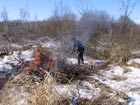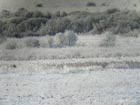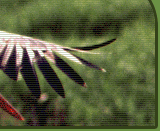Will Great Snipe return to the meadows of Lake Durbe? A public information meeting has been called to involve land owners and other stakeholders in the process of development of the management plan for the Lake Durbe Meadows Nature Reserve. The meeting took place on 24 April at 16.00 in the Durbe community house.  | | Great snipe during | | the lekking season | Will Great Snipe return to the meadows of Lake Durbe? A public information meeting has been called to involve land owners and other stakeholders in the process of development of the management plan for the Lake Durbe Meadows Nature Reserve. The meeting took place on 24 April at 16.00 in the Durbe community house. Over a year already restoration of floodplain meadows has been taking place in the NE part of Lake Durbe; bushes have been cleared and mowing once again started in the abandoned meadows. Financing for these activities was provided by the project Restoration of Floodplain Meadows of the EU LIFE-Nature program administered by the Latvian Fund for Nature. The Lake Durbe Meadows Nature Reserve is a Natura 2000 site, and a management plan for it is set to be developed this year. The Latvian Ornithological Society will do it, and Rolands Lebuss will lead the work. The project manager Inga Račinska noted that Durbe was a natural choice for the project activities; just like the rests of the fifteen project sites, it is one of the biologically valuable floodplain meadows in Latvia. Among such would also be the floodplains of Ziemeļgauja (North Gauja) and the Lubāns wetlands that are covered in other projects. The Durbe floodplains are a unique natural treasure not only in Latvia but on a European scale as well. This is due to the natural diversity of the meadows and because of the number of nesting corncrakes in the South Kurzeme region. Regional coordinator of the project, Jānis Reihmanis, noted that large areas of meadows and pastures in the flooding areas have overgrown with bushes. They are not being managed even though the owners do pay land tax. In some places beaver is the only land manager but their activities only flood even larger areas. At least ten beaver lodges have been counted in the few kilometers before the Lāņupe River flows into the lake. There is evidence of the area covered by the meadows decreasing: back in 1935 the Dunalka parish had almost 1200 ha of meadows and pastures; today the total area has shrunk exactly two times to 560ha. Restoration of the meadows would provide new habitats for the endangered plant and bird species. Aside from corncrake a particular attention should be paid to the lesser spotted eagle that chooses floodplains as its feeding ground.  | | Bush cutting at Lāņupe | The great snipe is also a noteworthy bird species: in the days of the Kurzeme Duchy it was considered a rather common game bird, yet today they have disappeared from Kurzeme. One of the last mating rituals fights of the great snipe was observed just on the banks of Lake Durbe. Restoration of meadows gives hope for attracting the bird to its historic habitat, says the representative of the Fund. Currently contracts have been signed for cutting 27 ha of bushes in the overgrown meadows and for primary mowing of 40 ha of meadows. Most of these activities have been already completed and local inhabitants have received over five thousand lats. Restoration of floodplain meadows continues and financing is still available. Head of the management plan development team, Rolands Lebuss, is ready for serious work: this is not a simple territory. It has a very close connection with the entire Lake Durbe, even though the nature reserve includes only the NE side of the lake. After adjustments of 12 km of the river carried out back in 1929-1930 and 1961-1964, the water level has decreased by about a meter. Regular pollution coming into the lake has fostered its overgrowing; the bottom of the lake is covered with a thick layer of sludge. Sluices have been planned for the Durbe River already in 1961, but they were never built. For the Saka River too regulation of the water level was planned in 1971 by building sluices, a dam, and a polder. Considering preservation of fish resources, a similar idea of raising water lever in the lake is being developed now. This would most certainly affect the floodplain meadows found in the nature reserve. These and other question would be particularly important in the course of the year while the management plan is being drawn. It would include future management and protection possibilities of the territory for the next ten years. This is why involvement of all the stakeholders is particularly important.  | | A view of Lake Durbe | | meadows from Dupeļi | Some of the land owners have already acknowledged the privilege of owning meadows within a nature reserve. It qualifies them for additional financing to support meadow restoration; they can also receive EU subsidies from the Rural Development Plan (138EUR/ha for preservation of biologically valuable grasslands, 28EUR/ha for a Natura 2000 status, and other potential payments). Interest in meadow management has already borne its fruits: more open floodplain meadow landscapes in the area. It gives hope that one day the great snipe will return here to perform its bellicose nocturnal mating rituals. It would be one more battle of Durbe that brings a positive outcome a victory over bushes and abandonment. In some of the few Latvian floodplains the great snipe should have already returned from its long trip back from the wintering grounds; now it has to save up strength for the fights it performs during mating rituals. Andris Klepers | 






